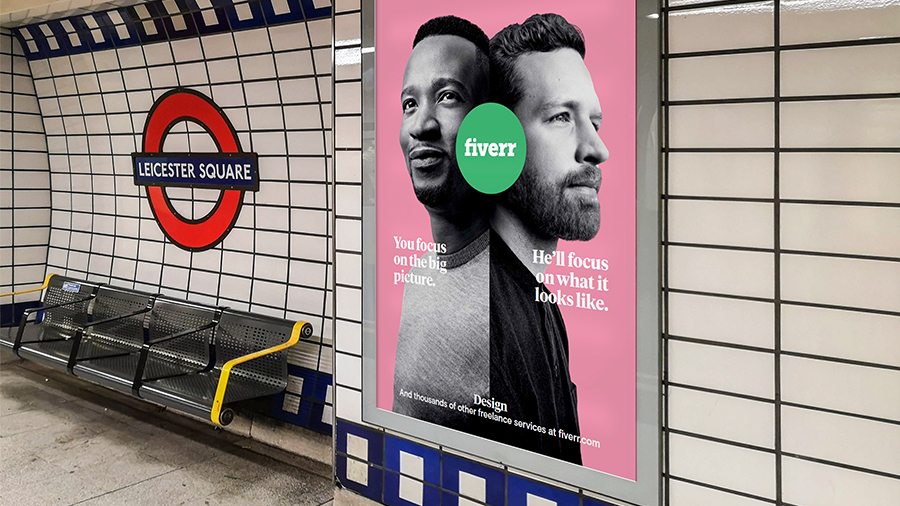What Is advertising?
Advertising definition and examples
 August 18, 2020
August 18, 2020 10 minute reading
10 minute reading
If you're new to the world of advertising, it's easy to feel overwhelmed. Some of the best ads seem effortlessly simple and memorable, but when you turn to actually creating ads, the process can feel a lot more difficult. There are new ideas and concepts to learn and apply to your planning. Plus, advertising can be expensive, and you might be hesitant to spend advertising dollars when you're not sure if they'll work.
If you're not targeting the right ads to the right audiences, you may not see compelling results. When that happens, you risk losing money instead of gaining new customers. How can you make the right advertising choices and grow your business?
The good news is that many advertising concepts are very straightforward, and with a little background information, a lot of your concerns around advertising will disappear.
With this guide, you'll learn what an advertisement exactly is, and why it is so important to business.
Ready to learn more? let's go...
What is advertising? objectives, importance & examples
1. What is advertising?
Advertising is a form of communication that uses persuasive messages to influence potential customers to take a specific action toward what is publicized. Through advertisements, youhelp people know about your products or servicesand find the best fits for their needs. When you advertise, you pay for a space to promote your product or service. You can use various advertising techniques to reach people and encourage them to buy from you. Print ads in magazines, TV and radio commercials, banner ads on websites, and billboards are all examples of advertising.
2.广告的目标是什么?
Before you consider what type of ads you need, you should know the four primary objectives of advertising, which are:
Trial: This type of ad aims to get people to try out your company or product for the first time. You may use this advertising approach when you launch your company or introduce new products to the marketplace.
Continuity: These ads target your customers to help increase loyalty and repeat purchases. For example, you may recommend products to current customers through ads to cross-sell and up-sell.
Brand switch: This advertising style aims to lure consumers away from your competitors. With these ads, you may highlight the compelling benefits of your products or services or offer discounts to win new customers.
Switching back: With these ads, you strive to win back customers who have defected to competitors. Typical ads may focus on promotions, discounts, or product improvements.
3. Why is advertising important?
We've covered what advertising actually is. But why is advertising important? Here are ten reasons why advertising is a must for every business:
It makes you money: Simply put, advertising is an exceptional wayto reach target audiencesand turn them into customers. When people see positive and engaging ads about your business, they are more likely to buy from you.
It keeps people updated on your business: With advertising, you can inform audiences about new products and services. You canreach out to audiences via adsinstead of expecting that they'll track down information about your company.
It helps people remember you: We live in an era of "information overload." Many brands compete for your audience's attention. When you advertise, you can stay top-of-mind with audiences so that they consider you when it's time to buy.
It produces ongoing business: Through ads, you can generate awareness and name recognition. Every day, there is likely at least one customer who needs what you have to offer. Advertising reminds them of those needs and helps bring a steady influx of customers to your business.
It helps you stay competitive: With so much competition in today's marketplace, you need to stand out. Advertising can help differentiate you from competitors and let people know why you're the best choice for their needs.
It promotes repeat business: Ads can keep current customers informed about your business and make them feel positive about buying from you. You can remind customers why they chose you and motivate additional sales.
It draws new customers to you: There are always new people who are in the market for your products or services. Advertising makes your name and brand visible to potential new customers.
It boosts your image: With advertising, you can convey your core values and mission. This approach can attract value-driven customers to you and make people feel positive about doing business with you.
It brings in traffic: Whether you have a physical or online presence—or both—advertising draws traffic to you. Some of this traffic will turn into sales, and that is good for your bottom line.
It fosters brand loyalty: With ads, you canbuild brand recognition and trust. You can send positive messages that help forge lasting relationships with customers.
4. Types of advertising
Traditional Advertising
In a nutshell, traditional advertising is anything that isn't online. This category of advertisements can include:
Television advertising
Radio advertising
Billboards
Direct mail advertising
Print advertising
Newspaper ads
If the advertising option existed before the rise of the Internet, it's traditional. Local businesses often do well with this kind of advertising. Consider a shop owner whose target market is a small city and surrounding areas. Billboards, radio ads, direct mail, and targeted print ads can reach a local audience. Also, traditional ads are a better fit for some demographic groups, such as older adults, that spend less time online.
However, traditional advertising can be pricey, and ads are difficult (or impossible) to update once they're placed. Another downside is that it's more challenging to know how people respond to your traditional ads or how much business it draws in. Keep these factors in mind when considering if and how to use traditional advertising.
Digital Advertising
Even if you see value in traditional advertising for your business, you should consider digital advertising, which includes any form of advertising online. These primary types of advertisements include:
Paid search advertising
Display advertising
Native advertising
Mobile advertising
Social media advertising
Video advertising
Email advertising
Podcast advertising
Why do you need digital advertising? Many people start any buying process online by searching, consulting reviews, or asking for recommendations on social media. With digital advertising, you can position yourself to be seen by hundreds or thousands of potential online customers.
数字广告也是高度可衡量的。你可以通用in information on how many people view your ad or engage with it by liking, commenting, or visiting websites. Another benefit of digital ads: They're typically cost-friendly. With some ads, you only pay when someone takes a designated action, such as clicking on a link and visiting your website.
What are the negatives to digital ads? They are dependent on technology, which is not failsafe. Plus, many digital ads rely on demographic information from online or social media users. Some people have valid security and privacy concerns, so digital advertising can seem too personal or intrusive at times.
5. Advertising examples
Example of digital advertising
Digital advertising is the type of advertisement that appears on the web, and it can be either text ads, or display ads including videos or images.
Paid search text advertisements such as the one within the example below, always appear either at the top or at the bottom of a search engine result page (SERPs) and include a heading, a display URL, and description text.

Example of outdoor advertising
There are different types of outdoor advertising such as billboards and banners, transit advertisements, street furniture outdoor advertisements, point of sale (POS) display advertisements, mobile billboards, and guerilla advertisements.
Transit advertisements such as the one below are mostly seen on the side of buses, in subway, metro stations, and airports.

6. Advertising tips for creating successful ads
Before you start creating your advertising campaigns, it's crucial to understand how to make them as successful as possible so you can make the most of your advertising spending. Every ad needs to reinforce your brand identity and convey clear benefits about your products or services to your target market.
Here are 9 tips to help you reach the goals you are hoping for:
What makes you stand out from your competition?大多数时候,我们遇到许多数以百计的广告,so any ad you create is competing for mindshare among your target audience. You must create a unique selling proposition (USP) that makes it clear why people should buy from you. Your USP must be truly unique to you and not be anything that competitors offer or promote.
How are you going to grab attention?啸叫脱颖而出的乱发广告tising, you must craft a compelling headline. How can you create an attention-grabbing headline? You can focus on something newsworthy or emphasize the benefits people will gain by buying from you. Another strategy is using a negative angle that taps into people's anxieties--and offering a solution. Even experienced advertising copywriters can spend a lot of time perfecting ad headlines. So don't shortchange this crucial step in ad creation. Keep in mind that the so-called "father of advertising" David Ogilvy had this to say about headlines: “On average, five times as many people read the headline as read the body copy. When you have written your headline, you have spent eighty cents out of your dollar.”
What can you offer people to get them to buy?Effective ads offer something compelling to potential buyers. These offers can include limited-time discounts, no-cost trial opportunities, or free shipping. Often, these promotional offers give people a reason to try out your products or services. Or, you can use them to re-engage or build more business with existing customers.
What benefits will people gain by buying from you?Remember that people will buy from you when they understand how it benefits them. Don't make the mistake of only focusing on features in your ads. Instead, clearly convey the benefits customers receive. When creating ads, keep in mind these words of wisdom from advertising guru Leo Burnett: “Don’t tell me how good you make it; tell me how good it makes me when I use it.”
How can you make buying from you feel low-risk?Spending money can make people feel nervous. And no one likes the feeling of post-purchase buyer's remorse. You can solve this problem by offering risk-free trials, money-back guarantees, and clear return policies.
Can you use testimonials from satisfied customers?Some people are skeptical about buying from unfamiliar companies or brands. But they're more than willing to buy based on others' recommendations. That's why using testimonials or positive reviews from happy customers is a powerful advertising tactic.
How can you encourage people to act now?The ultimate aim of your ad is to motivate people to take prompt action. In marketing, this is known as a "call to action" or CTA. Your CTA may ask people to buy your product, but not always. It could also ask people to sign up for a mailing list, follow you on social media, or take another action.
What visuals will be compelling to people who see your ad?You'll need some text to convey your offer, benefits, and CTA. But plain text ads usually aren't too interesting. Be sure to select some intriguing images to grab attention. Your visuals need to match your brand and the purpose of your ad for the best results.
How can people contact you if they want to learn more?If you've spent money on an ad, make sure you let people know where to find you and buy from you. Include a website or link in your digital ads. For print ads, you can list a website, phone number, or physical address.
Conclusion
Advertising is a critical tool to draw customers to a business. When you're first exploring the advertising, it's easy to feel overwhelmed by new terminology and options. But taking a step-by-step approach to learning about advertising can grow your expertise.
Most businesses have done hard work to define who they are and what they have to offer. When you advertise, you can communicate those messages to people who need your products and services. You can share your brand story and values and truly show what makes you unique. And you can show people why they should choose to do business with you. In time, you can draw the right customers to you and build loyalty.
Advertising can help you boost your bottom line, but you'll need to manage your advertising spend strategically. You need to be on top of your ad performance and metrics to gain the best ROI. That's not always easy, especially if you have other business responsibilities to manage. Seeking support from a Fiverr seller that knows advertising best practices can help you make the most of every advertising dollar.
Most likely, you'll need to start small and grow your advertising over time. But keep in mind that advertising is an ever-changing field—and your business and audience needs can shift too.



